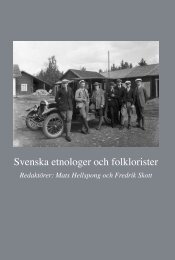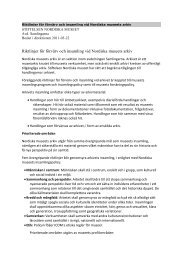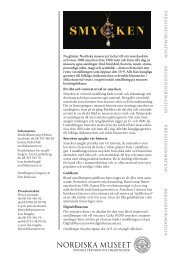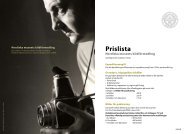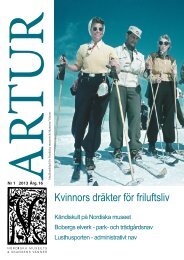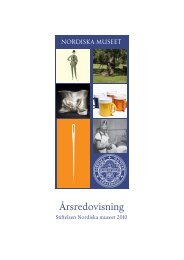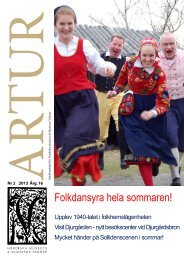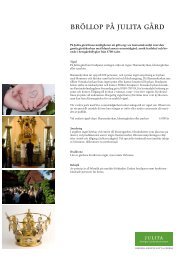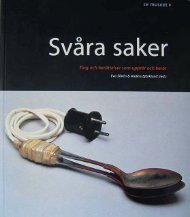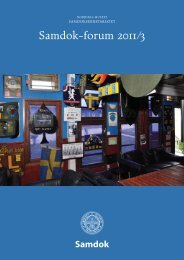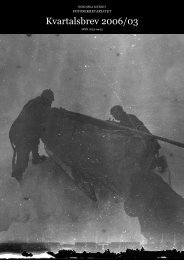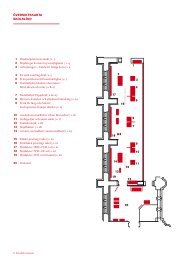Samdok - Nordiska museet
Samdok - Nordiska museet
Samdok - Nordiska museet
Create successful ePaper yourself
Turn your PDF publications into a flip-book with our unique Google optimized e-Paper software.
connecting collecting: thomlinson<br />
example at present is the stopping of Sunday collections.<br />
There has been a lot of coverage in press on this and the<br />
BPMA are currently collecting to reflect this.<br />
The BPMA also collects the topical/political issues<br />
of the contemporary postal service. This type of material<br />
is particularly good for displays and events in the<br />
future. Examples include material donated recently<br />
from the National Federation of Subpostmasters (NFSP).<br />
In 2006 they organised a rally and a petition against<br />
the Government taking vital business away from Post<br />
Offices and their plans to close a large number of Post<br />
Offices. The petition presented to the Prime Minister on<br />
18th October 2006 was the largest ever presented to the<br />
Government and consisted of four million signatures. It<br />
was so big a double decker bus had to be hired to transport<br />
the petition! Protests in Westminster and a lobby of<br />
Parliament followed.<br />
Another example is of material donated by the<br />
Communication Workers Union (CWU) that was used<br />
during the national postal strikes that have occurred with<br />
Royal Mail staff between June and October 2007 over<br />
pay, pensions and Royal Mail’s modernization plans. The<br />
material consisted of posters, leaflets, armbands, T-shirts<br />
and stickers produced by the CWU for use on the picket<br />
lines during the strikes. Two staff from the BPMA also<br />
filmed and made oral history recordings at the picket<br />
line of Mount Pleasant on the day of the first strike, 29th<br />
June.<br />
It is important to collect the people of the postal<br />
service. Oral history is one way to do this but there are a<br />
number of other ways too, such as through photographs,<br />
chat rooms and discussions blogs, staff magazines, diaries<br />
and objects associated with them (e g medals).<br />
Conclusion<br />
This has given you a very brief overview of what the<br />
BPMA has been doing to collect contemporary material.<br />
The policy has meant that contemporary material is being<br />
collected in a more structured way and as a result<br />
collecting has become wider and far more representative<br />
of the postal service as a whole. Continued monitoring<br />
and research means we do not miss out on new devel-<br />
opments and can tell a fuller story of the postal service<br />
of our times to future generations. A proactive approach<br />
means collecting the contemporary is no longer left to<br />
chance and hopefully means we are collecting now what<br />
is important for future generations to come.<br />
Reference<br />
Understanding the Future: Priorities for England’s Museums<br />
(2006). London: Department for Culture, Media and<br />
Sport.<br />
Image captions<br />
Fig 1. National Federation of Subpostmasters’ rally, October<br />
18th 2006. Photo & copyright: NFSP.<br />
Fig 2. BPMA volunteer interviewing postman Don Burrett prior<br />
to going out on delivery. Photo: Julian Stray, BPMA.<br />
Fig 3. BPMA Community Project with Royal Mail staff,<br />
February 2007. Photo: BPMA.<br />
Fig 4. Sue Buckley, Postmistress at Bringsty Common Post<br />
Office, hard at work behind her Post Office counter. Photo:<br />
Julian Stray, BPMA.<br />
44



